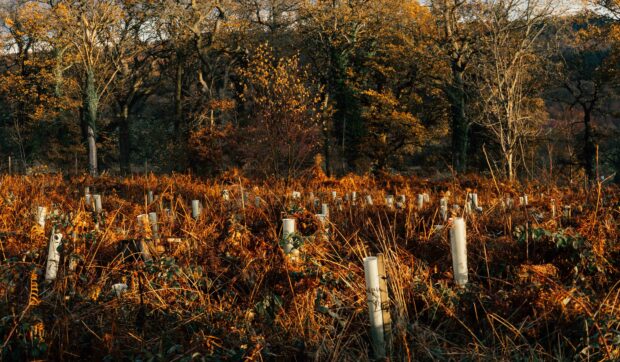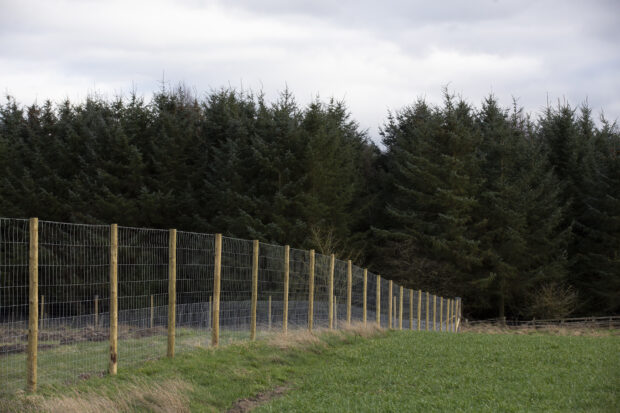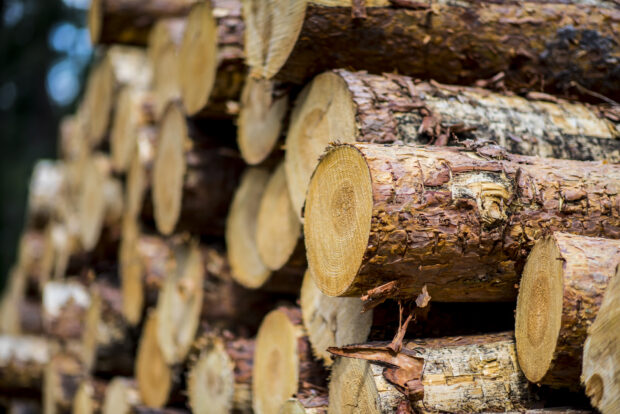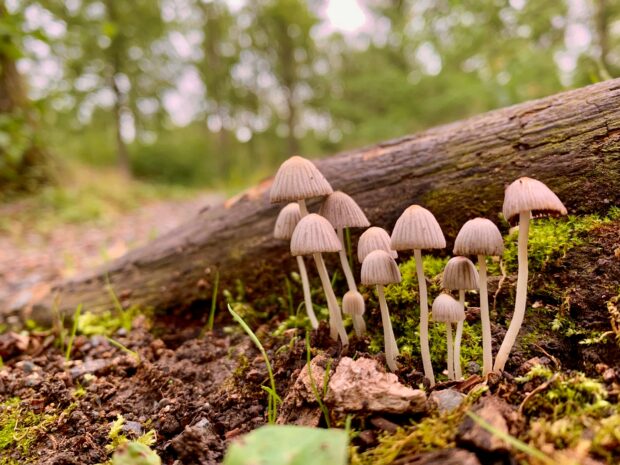 MacBradan Bones is a Nature Recovery Advisor for the Forestry Commission. Here he shares his tips for managing your woodland in autumn.
MacBradan Bones is a Nature Recovery Advisor for the Forestry Commission. Here he shares his tips for managing your woodland in autumn.
Autumn is a key time in the woodland calendar. It marks the start of tree planting season and visually it makes the biggest impact on our landscapes in the shortest amount of time, as the trees change colour and then lose their leaves.
If you own a woodland it's also the ideal time to get out and make sure it's in the best health to get through the cold winter months.
It can be hard to know where to start so we’ve put together our top 5 tips for managing your woodland this Autumn.
1. Check your tree guards
If you have any tree guards which are no longer needed, or need removing and replacing, now is a good time to do this as the scrub and weed growth will be dying down.
Also consider weed control around young trees if they are becoming overtopped and cut bracken before it folds over onto the trees. Competing vegetation can continue to grow through a mild winter so even if you can see the trees now, they might have been swamped by the spring.
Find guidance on how to reuse and recycle tree guards on GOV.UK: Tree protection: the use of tree shelters and guards.

2. Build protective fencing
The drop in temperature and the increase in rain at this time of year leads to softer ground so if you haven’t already done it, now is a good time to put up fencing to keep livestock or deer away from your trees. If you’re using machinery, be careful that it doesn’t cause soil compaction around tree roots.
Of course, this time of year is generally much cooler so you’ll also work up less of a sweat!

3. Prune and thin trees
During late autumn the sap is sinking in the trees, so if you have any pruning, thinning or tree maintenance that needs to be done now is the time to do it. This is especially important for broadleaves as you want to avoid the trees bleeding sap and becoming distressed.
It’s also an ideal time to carry out any felling needed as birds have fledged the nest and dormice are not yet hibernating. If you’re carrying out hardwood felling then you’ll also be ready for the annual winter hardwood auctions.
Don’t forget to check if you need a felling licence before carrying out any work. Our Tree felling: getting permission guide tells you what you need to know and how to apply.

4. Choose and order new trees
If you’re planning to expand your woodland or replant any felled areas this planting season, then now is a good time to choose and order your trees. Use biosecure trees from nurseries with Plant Healthy certification or similar to help protect against pests and diseases.
When you receive them, handle carefully, store them in a well-ventilated covered area and be mindful that bare root trees have a short 'shelf-life' of about two weeks. Cell grown trees have a longer shelf life and provide a bit more flexibility.
Trees can be planted anytime before very early spring but those planted before the end of the year have a chance to grow new roots sooner and are better able to survive spring droughts.

5. Look out for signs of tree disease
With the leaves off most broadleaf trees and some conifers, such as larch, it can sometimes be more difficult to detect signs of ill health in the trees. Look for those holding on to their dead leaves as this can be a good indicator that they have died. You can also keep a close eye on the bark for lesions and weeping as well as looking to the crown for dying twiggy branches.
Autumn is probably the best time for fungi, all of which are fascinating and play a key role in the woodland ecosystem, recycling nutrients and helping trees to take up soil minerals. Some, however, particularly those growing on the wood of living trees, can be a sign that the tree is diseased or dying. So if those trees are located where could pose a safety risk, have them checked by a qualified tree safety inspector or arboriculturist.
As a woodland owner you need to protect your trees from pests and diseases and simple biosecurity measures can stop them being introduced. Ask any visitors to clean their shoes and vehicles before entering your woodland and once they leave. Falling leaves can carry fungal diseases in the leaf litter and this prevents it spreading.
Information on how to identify and report tree pests and diseases can be found on GOV.UK.

Finally, take some time for yourself to enjoy the last strains of sunshine filtering through the trees. Getting out into woodlands brings a variety of health benefits both physical and mental and working now to prepare your site for winter will bring a great sense of satisfaction.
Find more advice on how to manage your woodland and the financial support available or follow us on X (Twitter).



2 comments
Comment by Paddy hall posted on
We have a small<2 acres woodland with some massive ash trees chalky steep Dale side over chalk alongside public road.
Is there any source of help with risk assessment/ management
We are fairly active late 70s!
Comment by Faye Dawson posted on
Hi Paddy, your local woodland officer can assist you with expert advice about managing your woodland. You can find details on how to contact the area office to get in touch with them on our website https://www.gov.uk/government/organisations/forestry-commission/about/access-and-opening#Area-Offices.